Discover the comprehensive guide to Belgard retaining wall installation‚ ensuring durability and aesthetic appeal. This step-by-step resource covers everything from preparation to completion‚ helping you create secure and attractive outdoor structures.
1.1 Overview of Belgard Retaining Walls
Belgard retaining walls are renowned for their durability‚ aesthetic appeal‚ and versatility. Designed to enhance outdoor spaces‚ these walls are ideal for residential and light commercial projects. They offer a range of styles‚ from modern to traditional‚ allowing homeowners and landscapers to customize their designs. Belgard’s systems‚ such as the Tandem Wall‚ provide flexibility for curved or straight configurations. These walls are perfect for creating functional and decorative structures‚ including garden walls‚ planters‚ and even wrapping columns. Their modular block systems ensure easy installation while maintaining structural integrity‚ making them a popular choice for hardscape projects.
1.2 Importance of Proper Installation
Proper installation of Belgard retaining walls is crucial for ensuring structural integrity and longevity. A well-installed wall prevents issues like uneven settling‚ drainage problems‚ and potential collapse. Correct techniques guarantee the wall’s stability‚ especially under heavy loads or harsh weather conditions. Improper installation can lead to costly repairs and safety hazards. Following the installation guide ensures the wall functions as intended‚ enhancing both functionality and aesthetic appeal. Properly laid walls also maintain drainage systems‚ preventing water damage and erosion. Investing time in accurate installation guarantees a durable and attractive retaining wall that withstands time and environmental stress.
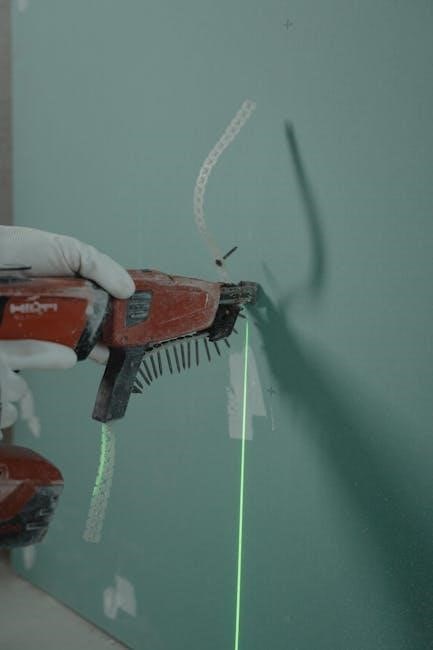
Preparation for Installation
Effective preparation is key to a successful Belgard retaining wall installation. This includes site planning‚ gathering essential tools‚ and organizing materials to ensure a smooth process.
2.1 Site Preparation and Planning
Begin by clearing the site of debris‚ vegetation‚ and obstructions. Ensure the area is level and evenly graded. Measure and mark the retaining wall’s dimensions accurately using stakes and string. Check for underground utilities to avoid damage. Verify local building codes and obtain necessary permits. Plan the layout to ensure proper drainage and structural integrity. Consider the wall’s height and the need for reinforcements like geogrid. Prepare a safe workspace with clear access for tools and materials. Proper planning ensures a smooth installation process and prevents potential issues down the line.
2.2 Tools and Materials Needed
To install a Belgard retaining wall‚ gather essential tools and materials. Tools include a shovel‚ trenching shovel‚ level‚ tamping tool‚ shovels‚ and a laser level for accuracy. Materials required are Belgard retaining wall blocks‚ geogrid for reinforcement‚ compactable gravel for the base‚ and backfill material. Sand or paver sand may be needed for leveling. Weather-resistant caps and sealants are optional for finishing. Ensure all materials are compatible with Belgard products for optimal performance. Having the right tools and materials ready ensures efficient and proper installation of the retaining wall system.
2.3 Safety Precautions
Ensure safety by wearing protective gear like gloves‚ safety glasses‚ and steel-toe boots. Work in pairs for heavy lifting and keep the site clear of debris. Follow manufacturer guidelines for tool use and avoid overexertion. Keep children and pets away from the work area. Be cautious with power tools and ensure proper handling of heavy materials. Have a first aid kit nearby and plan for emergencies. Avoid working in extreme weather or when fatigued. Proper safety measures protect both the installer and the integrity of the Belgard retaining wall installation. Always prioritize caution to prevent accidents and ensure a successful project.
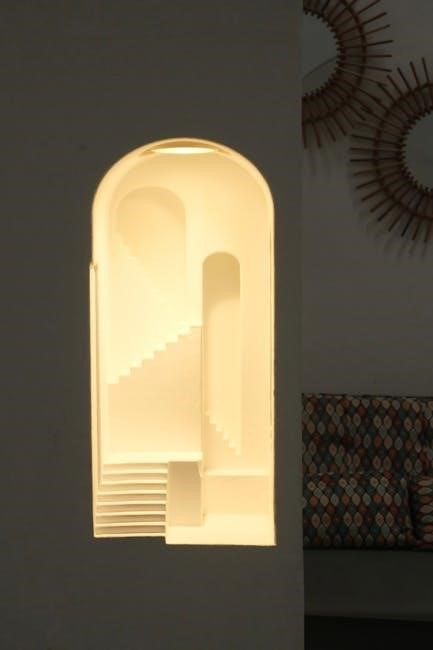
Understanding the Wall System
Understanding the Wall System is crucial for installation success. It involves knowing the design‚ materials‚ and functionality to meet structural requirements and ensure durability.
3.1 Components of the Belgard Retaining Wall
The Belgard retaining wall system consists of durable‚ engineered blocks designed for strength and structural integrity. Key components include the retaining wall blocks‚ geogrid reinforcement‚ and backfill material. The blocks are manufactured with a rear lip to prevent tipping and ensure a secure fit. Geogrid is used to reinforce the structure‚ enhancing stability and load-bearing capacity. Properly graded backfill and drainage materials are essential to prevent water accumulation. Additional components like caps and coping stones are optional for finishing touches. Each part plays a vital role in creating a durable‚ visually appealing retaining wall system.
3.2 Types of Retaining Walls (Gravity‚ Geogrid‚ etc.)
Belgard retaining walls are available in two primary types: Gravity and Geogrid. Gravity walls rely on their weight and interlocking design to resist soil pressure‚ making them ideal for lower-height applications. Geogrid walls incorporate geogrid reinforcement‚ which is embedded in the backfill to enhance stability and support taller structures. Other types include Cantilever walls‚ which use a footer for support‚ and Counterfort walls‚ which add additional reinforcement. Each type is suited for specific conditions‚ ensuring structural integrity and aesthetic appeal based on the project’s requirements and soil characteristics.
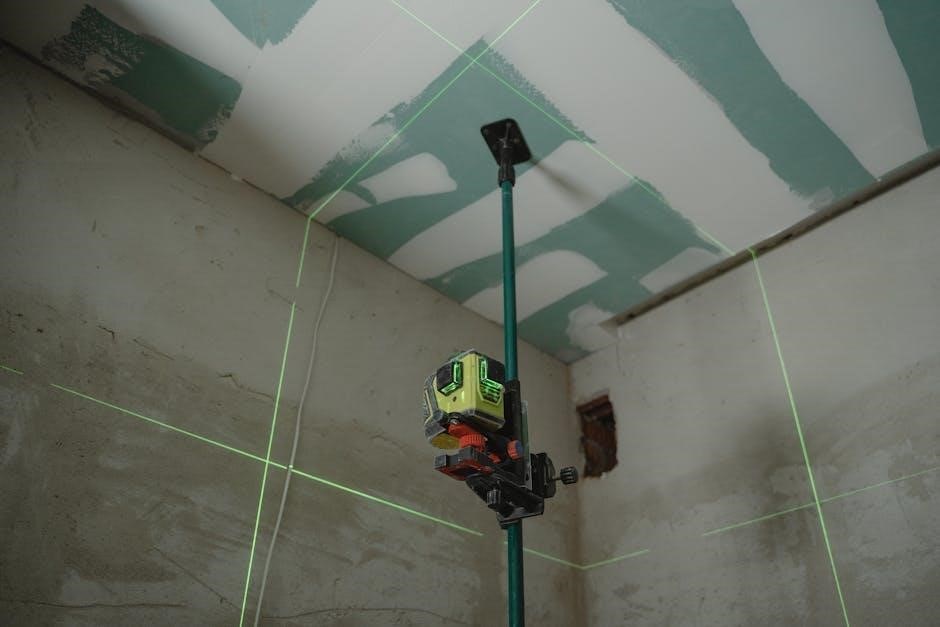
Excavation and Base Preparation
Proper excavation and base preparation are critical for a stable retaining wall. Mark the area‚ dig a trench‚ and prepare a compacted base layer to ensure a solid foundation.
4.1 Marking the Area
Begin by marking the area where the retaining wall will be installed. Use stakes and string to outline the perimeter‚ ensuring the dimensions match your design plan. Check for underground utilities and ensure compliance with local building codes. Use a laser level to verify the ground is even‚ making adjustments as needed. Proper marking ensures accurate excavation and alignment for the wall’s foundation. This step is crucial for the structural integrity and aesthetic appeal of your Belgard retaining wall.
4.2 Digging the Trench
Digging the trench is a critical step in Belgard retaining wall installation. The trench depth typically ranges from 6 to 12 inches‚ depending on the wall height. Use a shovel or backhoe for precise excavation. Ensure the trench is level and even‚ using a laser level or carpenter’s level for accuracy. Once dug‚ compact the soil at the base to create a stable foundation. Proper trench preparation prevents settling and ensures the wall’s structural integrity. Always check for underground utilities before digging to avoid complications.
4.4 Compacting the Base
Compacting the base is essential for a stable Belgard retaining wall. After digging the trench‚ fill it with a 2-3 inch layer of compactable material like gravel or crushed stone. Use a hand tamper or plate compactor to firmly pack the material‚ ensuring no air pockets remain. Repeat this process until the base is solid and even. Proper compaction prevents shifting and settling over time. Check the base level frequently and make adjustments as needed. A well-compacted base ensures the retaining wall’s structural integrity and longevity. Follow manufacturer guidelines for the recommended material and compaction methods.
Laying the First Course
Laying the first course begins with a sturdy base and proper alignment to ensure stability. Ensure the surface is level and compact for a solid foundation.
5.1 Leveling the First Layer
Leveling the first layer is crucial for a stable structure. Use a spirit level to ensure the base is even. Place the first block‚ check alignment front-to-back and side-to-side. Adjust by adding or removing base material. Repeat for each block in the course‚ maintaining consistency. Use a tamping tool to secure blocks firmly. Ensure each block aligns with the previous one to avoid misalignment. A well-leveled first layer ensures the rest of the wall builds correctly. Take time to verify each block’s position for a professional finish. Proper leveling prevents structural issues and ensures long-term durability.
5.2 Aligning Blocks Properly
Aligning blocks properly ensures structural integrity and visual appeal. Start by using a spirit level to verify each block is plumb and level. Use a string line as a guide to maintain straight edges. For curved walls‚ mark the radius on the ground and align blocks accordingly. Place each block tightly against the previous one‚ ensuring joints are consistent. Check alignment frequently to avoid misplacement. Proper alignment prevents uneven settlement and enhances the wall’s stability. Use Belgard’s alignment guides or pins if available. Consistent alignment ensures a professional-looking finish and long-lasting performance.
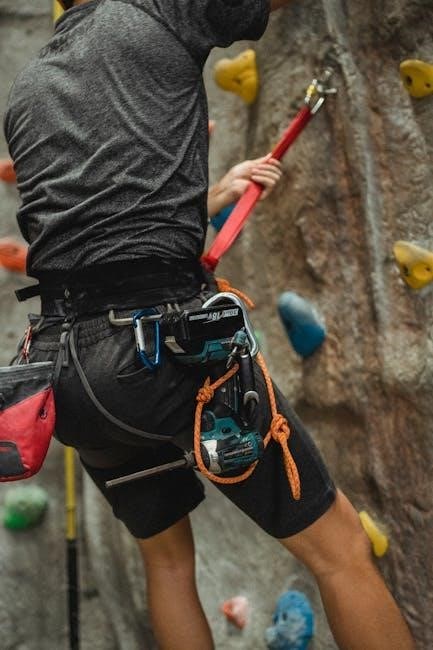
Building the Wall Structure
Stack courses evenly‚ ensuring alignment and stability. Use geogrid for reinforcement in taller walls. Maintain proper drainage and backfill as you build upward for structural integrity.
6.1 Stacking Subsequent Courses
Stack subsequent courses by leveling each block and ensuring alignment with the course below. Use a spirit level to verify accuracy and plumbness. Check that each block aligns with the joints of the course beneath it for structural strength. Lightly tap blocks into place using a rubber mallet to avoid damaging the units. Periodically inspect the wall’s alignment using a string line or laser level. Maintain the recommended pattern‚ such as a standard running bond‚ to prevent weak spots. Backfill and compact soil behind the wall as you progress to ensure stability and prevent shifting. Always wear gloves when handling heavy blocks to ensure safety.
6.2 Using Geogrid for Reinforcement
Geogrid is a synthetic material used to reinforce retaining walls‚ enhancing their structural integrity. Cut the geogrid to size‚ ensuring it extends behind the wall and into the backfill. Place the geogrid between courses‚ aligning it with the blocks for even distribution of weight. Secure the geogrid tightly to prevent movement‚ and ensure it is not twisted or bunched. Install geogrid layers at intervals specified by the manufacturer‚ typically every few courses. This reinforcement helps resist soil pressure and prevents wall shifting or bulging over time. Proper installation ensures long-term stability and performance of the Belgard retaining wall system.
6.3 Ensuring Drainage
Proper drainage is essential to prevent water accumulation behind the wall‚ which can cause structural damage. Install a drainage system by placing a layer of gravel or aggregate behind the wall. Use a perforated pipe to collect and redirect water away from the structure. Ensure the pipe is sloped correctly and covered with geotextile fabric to prevent clogging. Regularly inspect and maintain the drainage system to ensure water flows freely. Proper drainage helps maintain the wall’s stability and prevents erosion or damage from hydrostatic pressure over time. This step is critical for the long-term performance of the Belgard retaining wall system.

Backfilling and Compacting
Backfilling involves filling the space behind the wall with soil or gravel‚ then compacting it to ensure stability and prevent settling. This step is crucial for the wall’s durability.
7.1 Adding Backfill Material
After laying the blocks‚ backfill material such as gravel or soil is added behind the wall to fill gaps and provide structural support. Ensure the material is evenly distributed and compacted in layers to prevent settling. Use a level to check the surface and avoid overfilling‚ which can distort the wall’s alignment. Proper backfilling ensures the wall remains stable and drains effectively. Always follow manufacturer guidelines for recommended materials and filling techniques to maintain the integrity of the Belgard retaining wall system.
7.2 Compacting the Backfill
Compacting the backfill is crucial for ensuring the stability and longevity of the retaining wall. Use a hand tamper or plate compactor to firmly compress the material in layers‚ starting from the bottom and working upwards. Proper compaction prevents settling and shifting‚ which can lead to structural issues. Ensure the backfill is evenly distributed and compacted thoroughly‚ especially around drains and geogrid reinforcements. This step ensures the wall remains level and secure‚ providing long-term durability and preventing erosion or movement over time;

Finishing Touches
Final steps include installing decorative caps and applying a protective sealant. These touches enhance durability‚ visual appeal‚ and ensure the wall’s longevity and structural integrity.
8.1 Installing Caps and Coping
Install caps and coping to protect the wall’s top edge and enhance its appearance. Use durable materials like concrete or natural stone for the caps. Ensure they are level and securely fastened with adhesive or mortar. Align the caps evenly‚ leaving minimal gaps between them. For a polished look‚ seal the gaps with a weather-resistant sealant. This step not only adds visual appeal but also prevents water damage and erosion. Proper installation of caps and coping is essential for the wall’s long-term stability and aesthetic value. Regular maintenance ensures they remain in pristine condition.
8.2 Sealing the Wall
Sealing the wall is a critical step to protect it from weathering and stains. Use a high-quality sealant specifically designed for concrete or stone surfaces. Apply the sealant evenly‚ following the manufacturer’s instructions‚ ensuring full coverage. Allow the first coat to dry completely before applying a second coat for maximum protection. Regular reapplication every few years will maintain the wall’s appearance and durability. This step prevents moisture damage and extends the lifespan of your Belgard retaining wall‚ keeping it looking like new for years to come.

Safety Considerations
Always wear protective gear‚ including hard hats‚ gloves‚ and safety glasses. Use proper lifting techniques to avoid injury. Ensure the site is clear of hazards and well-ventilated.
9.1 Working with Heavy Materials
Handling heavy Belgard blocks requires caution to prevent injuries. Always use proper lifting techniques‚ bending at the knees and lifting with your legs. Consider using machinery or a team to manage larger or heavier blocks. Ensure a firm grip and clear pathway to avoid dropping materials. Wear sturdy gloves to improve grip and protect hands. Take regular breaks to avoid fatigue‚ and stay hydrated to maintain focus. Never lift beyond your capacity‚ as this can lead to strains or accidents. Prioritize teamwork for heavier components to ensure safety and efficiency during installation.
9;2 Ensuring Structural Integrity
Structural integrity is critical for the long-term performance of a Belgard retaining wall. Ensure blocks are laid level and plumb‚ with courses aligned squarely. Use a spirit level to verify each layer‚ and check for proper drainage to prevent water pressure buildup. Geogrid reinforcement should be installed as specified to enhance stability. Backfill material must be compacted evenly to avoid settling issues. Regularly inspect the wall for cracks or shifting blocks and address them promptly. Proper construction techniques and adherence to manufacturer guidelines are essential to maintain the wall’s strength and prevent structural failure over time.

Maintenance and Upkeep
Regular inspections and timely repairs are crucial for maintaining Belgard retaining walls. Clear debris‚ check for damage‚ and ensure drainage systems function properly to prevent structural issues over time.
10.1 Regular Inspection
Regular inspections are essential to maintain the structural integrity of Belgard retaining walls. Check for cracks‚ unevenness‚ or damage to blocks and mortar. Ensure the wall remains level and plumb‚ as settling can cause alignment issues. Inspect drainage systems‚ such as weep holes‚ to prevent water buildup‚ which can weaken the structure. Clean debris from surfaces and joints to maintain aesthetics and functionality. Address minor repairs promptly to avoid costly fixes later. Schedule professional inspections annually to identify and resolve potential issues early.
10.2 Cleaning and Repair
Cleaning and repair are crucial for maintaining the longevity of Belgard retaining walls. Start by removing dirt and debris using a pressure washer or brush. For stubborn stains‚ use a mild detergent and rinse thoroughly. Inspect for cracks or damaged blocks and replace them promptly. Repoint mortar joints if necessary‚ ensuring a weather-tight seal. For larger repairs‚ consult a professional to avoid structural compromise. Regular cleaning prevents mold and algae growth‚ while timely repairs maintain the wall’s stability and appearance. Addressing issues early ensures the wall remains durable and visually appealing for years to come.
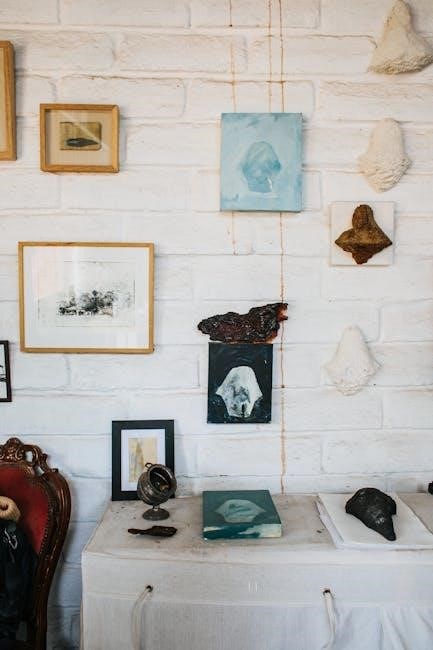
Troubleshooting Common Issues
Identify common issues such as cracks‚ uneven settlement‚ or poor drainage. Regular inspections can help catch problems early. Addressing these promptly ensures structural integrity and longevity.
11.1 Dealing with Uneven Settlement
Uneven settlement can cause structural issues and aesthetic problems. Inspect the wall for cracks or tilting blocks. Minor issues may be resolved by removing and releveling blocks. For severe cases‚ check the base for instability and reinforce it with compacted gravel or geogrid. Ensure proper drainage‚ as water accumulation can exacerbate settlement. If the problem persists‚ consult a professional to assess and correct the foundation. Regular inspections and maintenance can prevent further uneven settlement and ensure the wall’s stability over time.
11.2 Addressing Drainage Problems
Drainage issues can lead to water accumulation‚ causing erosion and structural damage. Inspect the wall’s drainage system‚ including pipes and gravel. Clear blockages and ensure water flows freely. If water pools behind the wall‚ check the backfill material and slope. Replace compromised backfill with proper drainage gravel. Ensure the ground slopes away from the wall to direct water flow. If issues persist‚ consult a professional to assess and repair the drainage system. Regular maintenance and inspections can prevent drainage problems and ensure the wall’s longevity and stability over time.
Successful Belgard retaining wall installation requires careful planning and precise execution. Proper techniques ensure durability and aesthetic appeal‚ enhancing your outdoor space while providing structural integrity.
12.1 Summary of Key Steps
Installing a Belgard retaining wall involves meticulous preparation‚ precise excavation‚ and careful block placement. Start with proper site planning and leveling‚ then excavate and compact the base. Lay the first course evenly‚ ensuring alignment and stability. Stack subsequent courses‚ incorporating geogrid for reinforcement and ensuring proper drainage. Backfill and compact thoroughly‚ then finish with caps and sealing. Regular maintenance and inspections are crucial for longevity. By following these steps‚ you can achieve a durable and visually appealing retaining wall that enhances your landscape and provides structural support.
12.2 Final Tips for a Successful Installation
For a successful Belgard retaining wall installation‚ adhere to the plan and take it one step at a time. Use high-quality materials and ensure proper drainage to prevent structural issues; Double-check leveling and alignment at each course to maintain stability. If unsure‚ consult professionals or Belgard resources for guidance. Finally‚ inspect your work regularly and address any potential issues promptly to ensure the wall’s longevity and aesthetic appeal.